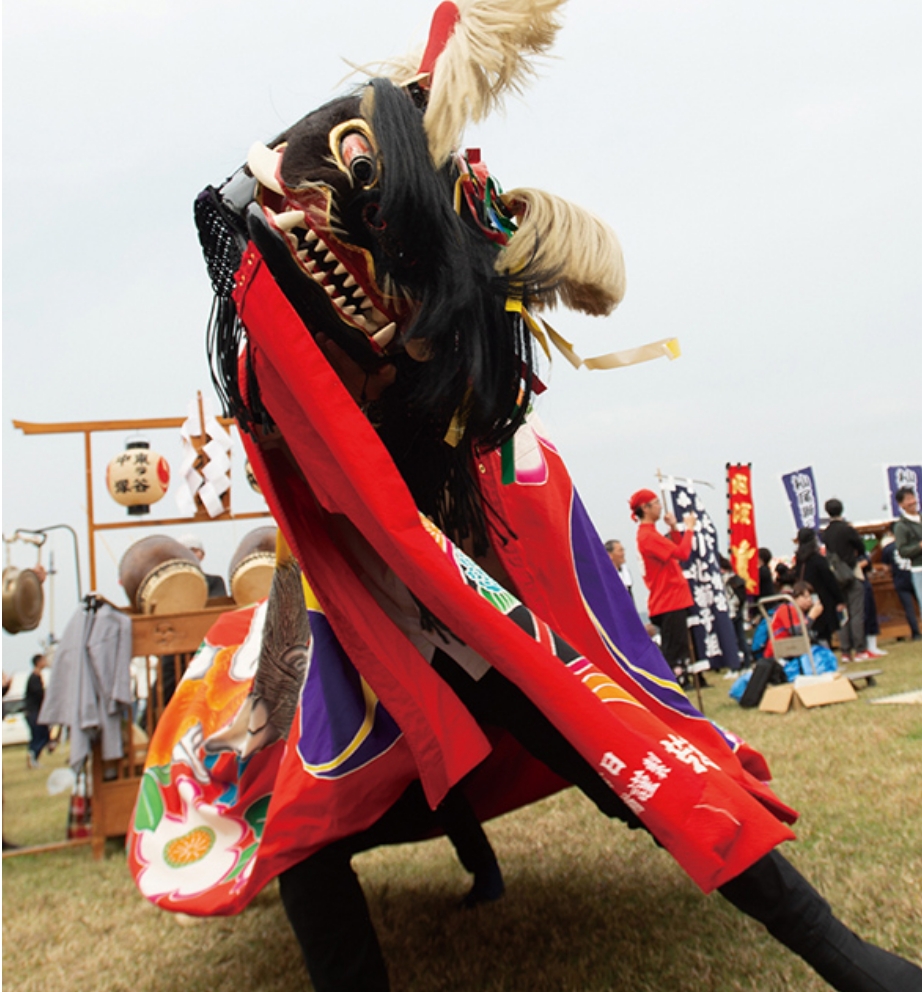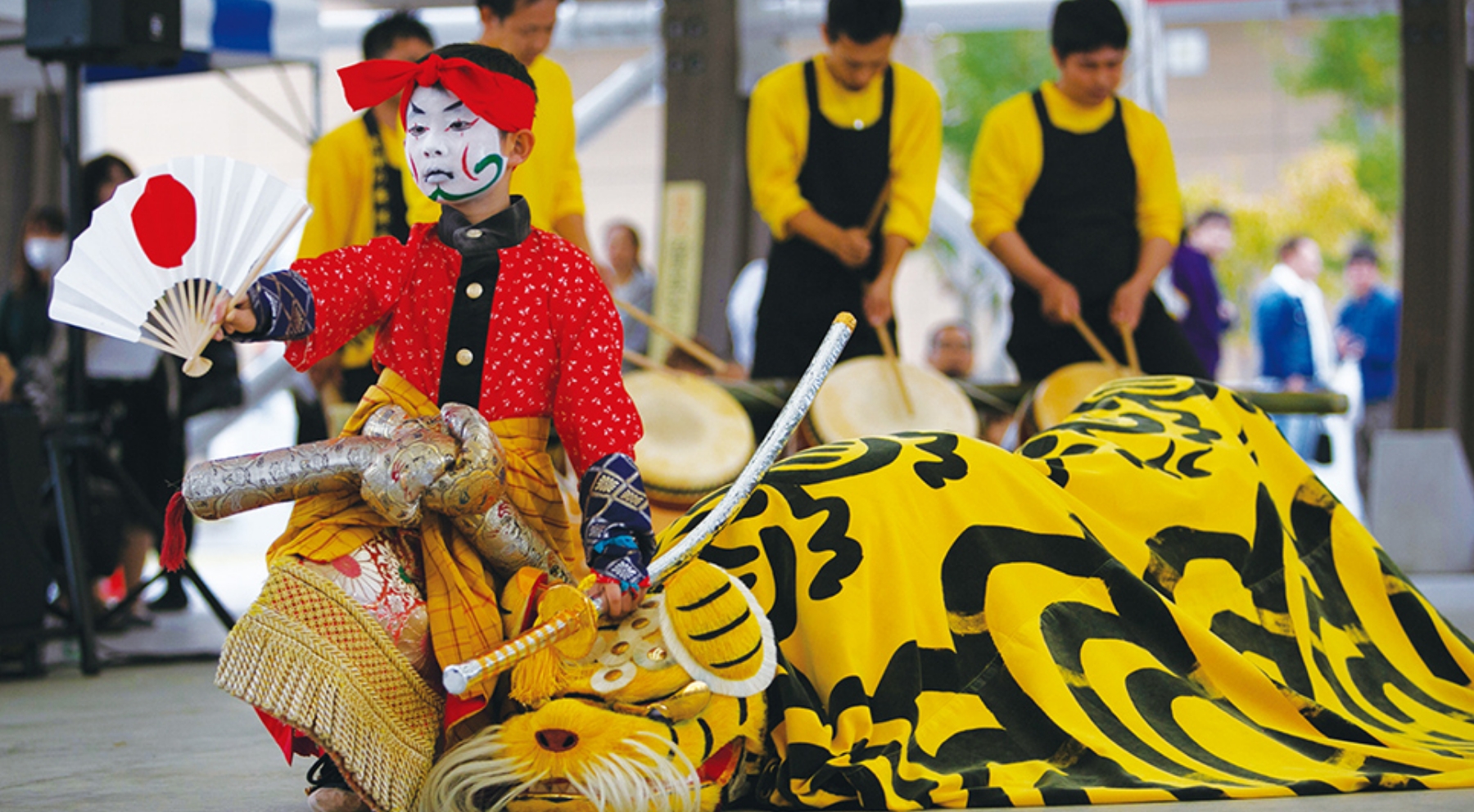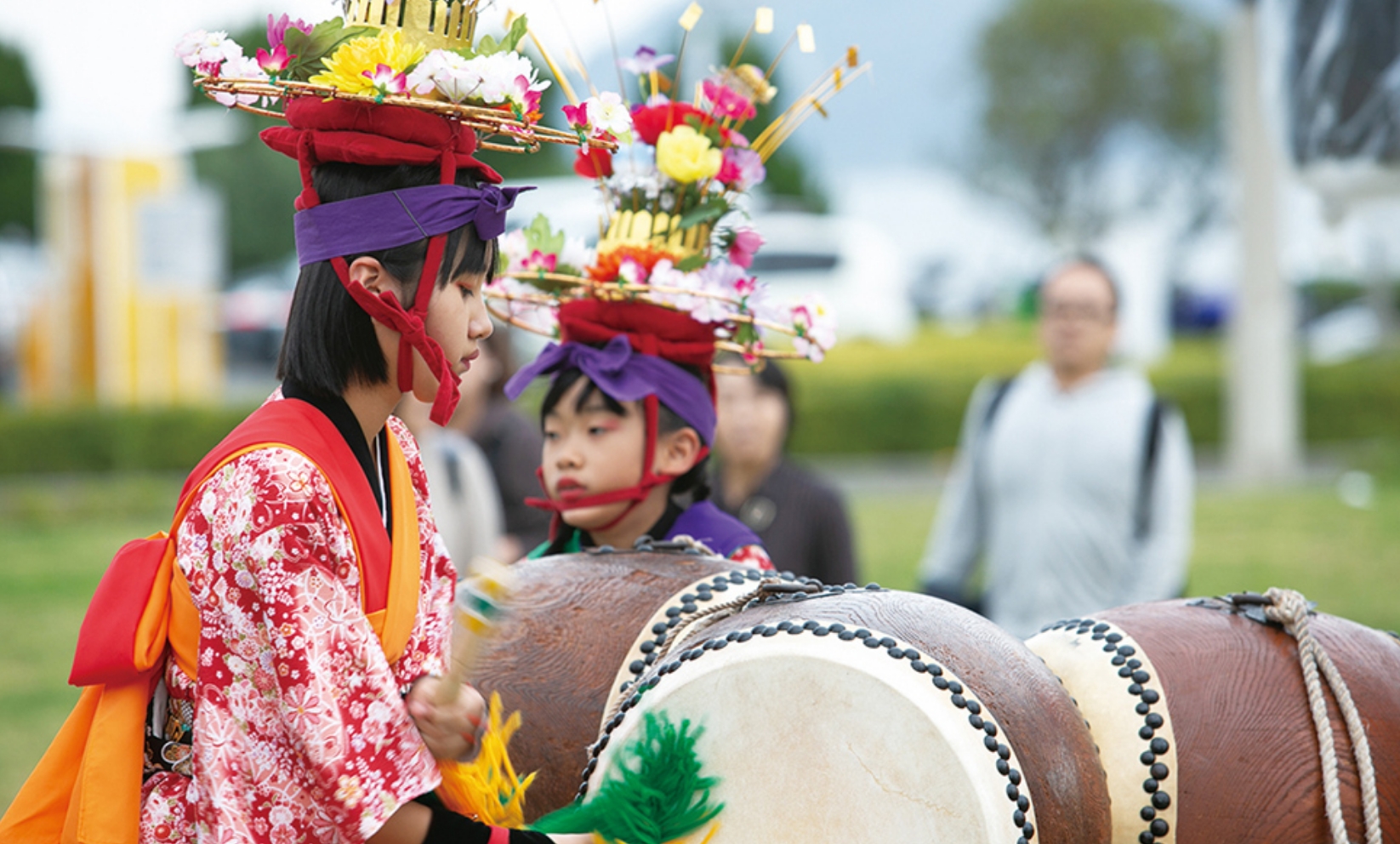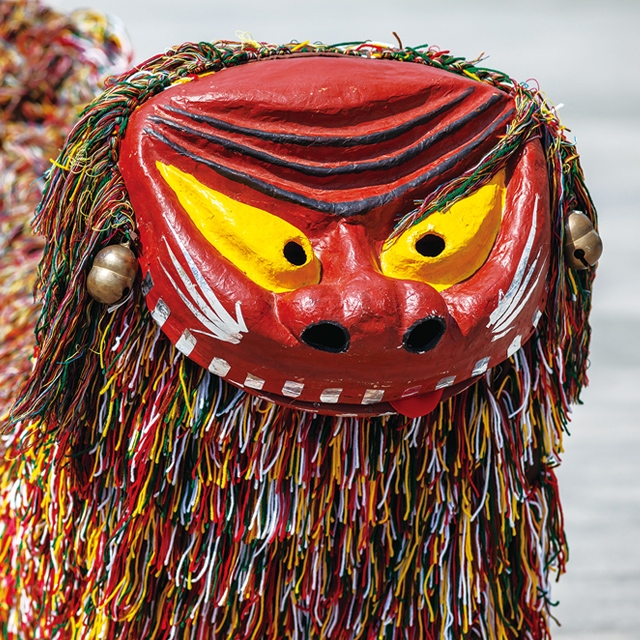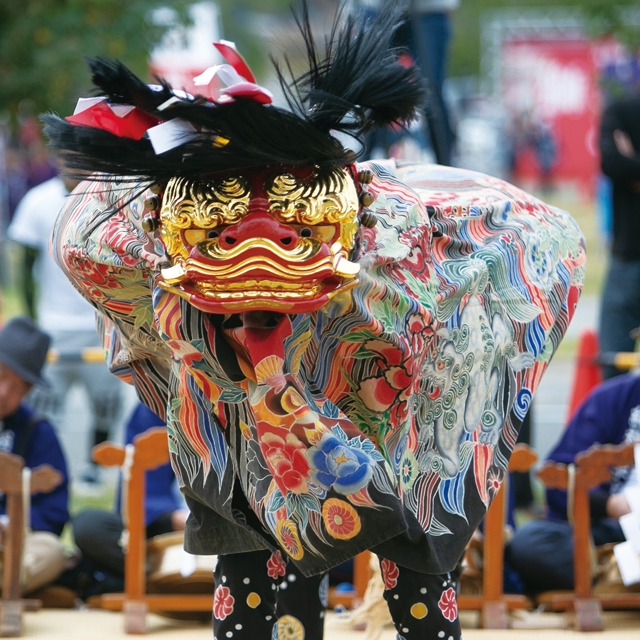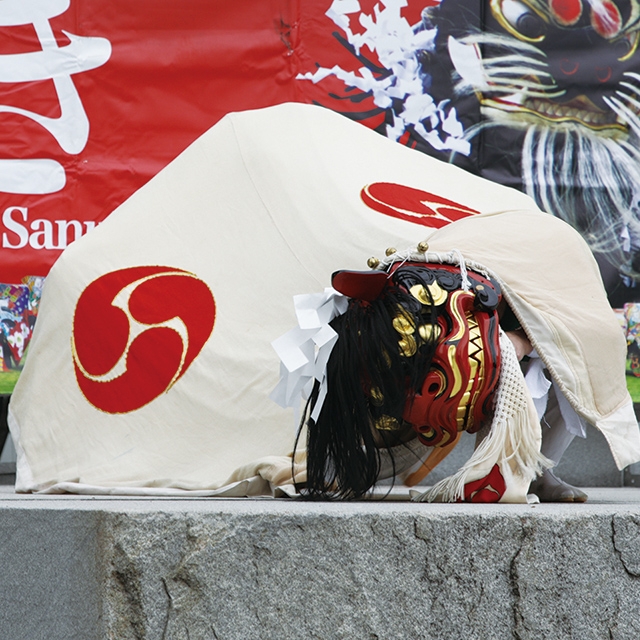
Visitor Guide
【History】
The lion, a sacred animal of India,
was introduced to Japan
through China and the Korean Peninsula,
undergoing some changes along the way.
The lion has been worshipped as a sacred animal in India from ancient times, and it can be seen sculpted on
entrances and columns in Hindu and Buddhist temples, as well as on pedestals of Buddha statues.
Idolized as a symbol of power and wisdom, the lion inspired the Lion Dance of China, a masked dance that drives away
evil spirits and brings in happiness. It then travelled through the Korean Peninsula and reached Japan,
where it turned into the unique Japanese traditional art of shishimai.

-

Statue of the Lion,India’s Sacred Animal
The statue called “Lion Capital of Ashoka” is used in the national flag of India, as well as coins, stamps, and passports.
-

Chinese Lion Dance
Today, people of Chinese decent in Southeast Asia practice the Lion Dance tradition during the Chinese New Year celebrations as a way to fend off the evil and bring in prosperity.
-

Korean Lion Dance
The Chinese lion dance was introduced to the Korean Peninsula as well.
-

Japanese Lion Dance (Shishimai)
The Japanese lion dance can be divided into two large types: the masked dance that came from China, and the Japanese indigenous dance that imitates deer and wild boars.
【Shishigumi】
Kagawa is one of the top
Japanese prefectures
in number of shishigumi*
Kagawa is one of the top Japanese prefectures,
in number of shishimai performances,boasting 800 shishigumi despite being the smallest prefecture in area.
In Kagawa, multiple shishigumi belonging to different local associations would perform in one shrine, so they strive
to be different, each competing to showcase their creativity in the lion’s head, its body covering, or choreography.
One particular reason for the popularity of the shishimai in Kagawa is the passion of the shishigumi members
in their engagement in shishimai.*Shishigumi is the shishimai troupe

【Shishimai】
Shishimai is performed at a jinja (a Shinto shrine)
to thank the gods for the year’s harvest.
Traditional kane and taiko
instruments accompany the performance.
In Kagawa, shishimai is performed from late September to early
November as part of the autumn festivals held at the shrines.
The lion dances to the accompaniment of the traditional kane and
taiko instruments from ancient Japan. Sometimes, children will dress up and join the performance.
In some regions, the custom still remains in which the shishigumi
will venture outside the shrine, performing for homes, stores, and companies.

Jinja
Jinja is a facility that enshrines the gods of Shinto, Japan’s indigenous religion. At the entrance of the jinja is a gate called torii, which represents the boundary between the sacred world of the gods and the world inhabited by humans.
-

shishimai
-

Kane performance
-

Taiko performance
-

Child performer
【Forms】
Two performers coordinate
to skillfully control one lion.
Many of the shishimai in Kagawa have two performers controlling one lion,
but in some cases the lion is controlled by a single performer.
When two performers are used, one is in charge of the head and front legs,
and the second is in charge of the hind legs.
Performing for long stretches of time in a crouched position inside the cover is a strenuous task.
The performer needs to keep up training to ensure strength and endurance of the lower body.
In addition to the physical demands, the front performer also needs experience
to master the skills in creating the lion’s facial expressions through control of its mouth and eyes.
In addition to the performances by a single lion,
there are also dance performances by groups of two or three lions.


Since ancient times, Japan has had a shishimai
in which one performer controls one lion.
This form originates from the traditional
shishiodori, which portrays deer or wild boars.
In Kagawa, the lion of the single-
performer shishimai has the same face as that
of the two-performer version.
【Shishigashira】
Shishigashira is made using paper mache,
with the techniques
from Kagawa’s traditional lacquerware craft
The head of the lion is called the shishigashira. With big eyes and a nose and mouth,
its rugged face bares its teeth, and is adorned with vivid colors such as red and gold.
Most shishigashira in Kagawa are made by pasting together washi (Japanese paper) and
applying a lacquer finish in a technique called hariko. In some cases,
animal hair is implanted in the face during the hariko process.
This type of shishigashira is called kejishi.
The shishigashira made from paper and lacquer are light, strong, and easy to handle.
Wood-carved shishigashira are rare in Kagawa but are common in other prefectures.
-

Hariko (Painted Lion)
Layers of washi (Japanese paper) are pasted
over a frame for the lion’s head. A lacquer finish
is applied in the end. -

Hariko (Kejishi)
Long hair is implanted in the face of the
shishigashira made by hariko. It is sometimes
called nekojishi, or “cat lion”, due to its
resemblance to a cat.

Kibori
A shishigashira made by carving wood.
The disadvantage is that it is
heavier than the hariko.
【Yutan】
Lavish artwork and patterns
adorn the lion’s trunk.
In Kagawa, the fabric covering worn by the shishimai performers is called yutan.
The yutan can be categorized by the type of artwork: mushae-yutan depicts samurai in action, mon-yutan is
adorned with the crest of a clan or a jinja, and kemoyō-yutan has patterns designed based on animal fur.
There is also the ke-yutan, which has animal hair sewn on to the fabric.
Please look out for the lavish yutan, which characterize the shishimai of Kagawa.
Artwork of the famous “Fan Target” story
in the Battle of Yashima of the Genpei War
In 1185, two samurai forces clashed in the Battle of Yashima (a peninsula in Takamatsu City, Kagawa Prefecture), with one side positioned on the sea and the other on land. When dusk came and they entered a ceasefire, the side on sea raised a fan up high, and dared their enemies to hit it with their bow and arrow. Nasu no Yoichi, an expert archer on the land force, rode up to the water’s edge on his horse, and while mounted, hit the fan with his arrow.
This story, set in Kagawa, is known as the “Fan Target” by many people in Japan.

-

Ke-yutan
In ke-yutan, the hair of an animal such as a horse is sewn onto the cloth.
-

Mon-yutan
The mon-yutan depicts the crest of a clan or a jinja, or emblems of things in nature such as flowers and birds.
-

Kemoyō-yutan
In ke-yutan, the hair of an animal such as a horse is sewn onto the cloth.
-

Mushae-yutan
A style unique to Kagawa Prefecture, the mushae-yutan depicts samurai in action. The vigorous movement of the shishimai brings the samurai in the artwork to life.
【Narimono】
The kane, taiko, and child performers
liven up the act
The lion is the star of the shishimai, but the kane and taiko that accompany
the movements of the lion are also indispensable to the performance.
In some shishigumi, child performers make appearances dressed up in their costumes,
adding some extra jubilance to the performance.
Kane
The kane is a traditional Japanese instrument made of metal shaped like a shallow basin. The performer strikes it with a wooden mallet to produce the sound. It is sometimes played using an instrument resembling a cymbal.Different regions and shishigumi have their own ways of hanging and striking the kane.
Taiko
The taiko used in Kagawa are mostly made using wooden drum bodies hollowed out in the shape of a barrel and fitting leather drum skins using tacks. We use Taiko with short bodies and large taiko in which strings are passed through holes at the edge of the leather and fastened tightly.
The size and shape of the taiko vary, as well as the pedestals on which they are mounted.
Child performers
The child performers wear woven hats with decorations
and bright costumes. They sometimes perform on the
taiko and sometimes dance with the lion.
